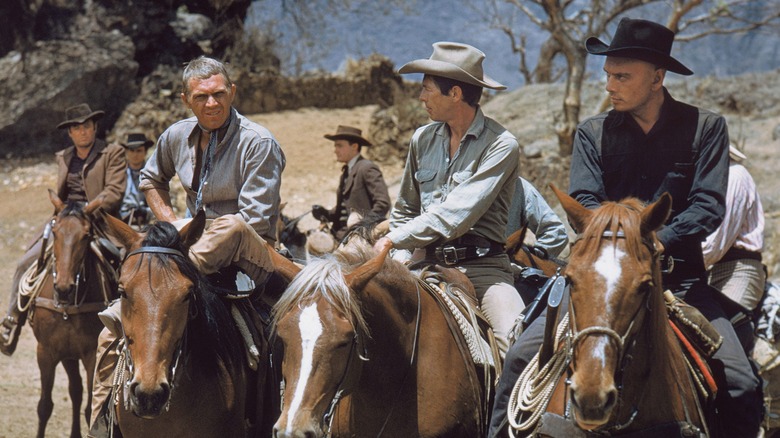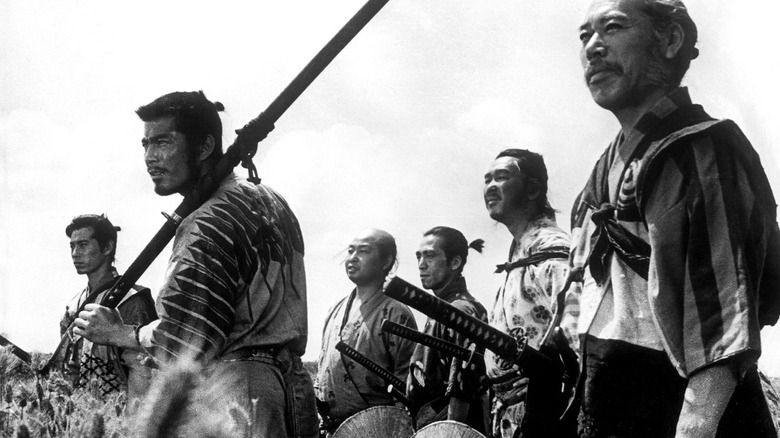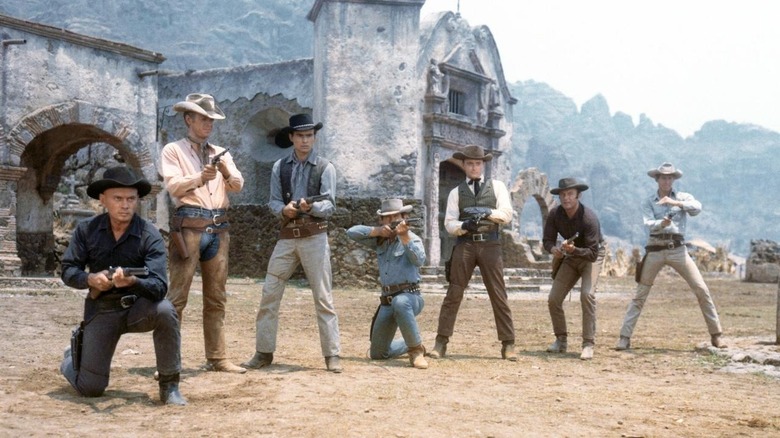John Sturges Believed Anything Could Be A Western, And The Magnificent Seven May Have Proved It
Despite the cultural differences, there has been a long and fascinating dialog between Japanese and western cinema. Just take "Yurusarezaru Mono," or "Unforgiven" as it is known by its English title, a remake of Clint Eastwood's Oscar-winner focusing on a former samurai instead of a former gunslinger. "Unforgiven" was Eastwood's rumination on his "Man With No Name" persona, which he first established in "A Fistful of Dollars," Sergio Leone's unofficial remake of Akira Kurosawa's "Yojimbo" where Eastwood played a gunslinger instead of a samurai. Kurosawa was a big western fan and an admirer of John Ford; you can see elements of this in his seminal "Seven Samurai," not least the small band of protagonists steeling themselves against overwhelming odds.
That's before you get into the American remakes of Japanese films. You have Roland Emmerich's godawful "Godzilla" and the surge in J-horror rehashes after the success of "Ringu" (which became "The Ring" in the US) through to the ill-advised live-action remake of "Ghost in the Shell" with Scarlett Johansson. One of the first and most successful adaptations was John Sturges' "The Magnificent Seven," which swapped out samurais and the medieval setting of Kurosawa's "Seven Samurai" for the Old West and a septet of heroic gunfighters.
Given that samurai films are to Japanese cinema what westerns were to the Golden Age of Hollywood, the idea of transposing Kurosawa's epic to a western setting doesn't seem all that wild. Yet critics at the time felt that Sturges' remake, which put together a dream-team ensemble including Yul Brynner, Steve McQueen, Charles Bronson, and Charles Coburn, was far inferior to Kurosawa's more nuanced source material. Over time, however, Sturges' assertion that any story, including Japanese samurai movies, could be successfully adapted into a western was proven right.
The influence of Kurosawa on western cinema
Almost 30 years since he passed away, Akira Kurosawa remains one of the most well-known and influential of all Japanese directors. His impact on western cinema cannot be overstated. Kurosawa first came to international attention when "Rashomon" won the Golden Lion prize at the Venice Film Festival in 1951, creating a catch-all word to describe narratives told from multiple points of view. Examples of Rashomon-style Hollywood movies include "The Usual Suspects," "Gone Girl," and a guilty pleasure of mine, "One Night at McCool's," which I'd argue is one of the most faithful spins on the formula.
George Lucas has admitted that Kurosawa's "Hidden Fortress" had a huge impact on "Star Wars: A New Hope," with characters from R2-D2 and C3P0 to Darth Vader having direct equivalents in Kurosawa's film. Kurosawa's biggest contribution came in his influence on westerns, which comes as little surprise with his adoration for the genre. He said in an interview with film critic Bert Cardullo (via Scroll):
"Good westerns are liked by everyone. Since humans are weak, they want to see good people and great heroes. Westerns have been done over and over again, and in the process, a kind of grammar has evolved. I have learned from this grammar of the western."
"Seven Samurai" provided the raw material for "The Magnificent Seven," which in turn became incredibly influential in its own right as a precursor to "The Wild Bunch" and men-on-a-mission movies like "The Dirty Dozen" and "Inglourious Basterds." Another of Kurosawa's films, "Yojimbo," was the template for the first of Sergio Leone's "Dollars Trilogy," creating the Spaghetti western and inspiring directors such as Sam Peckinpah, Martin Scorsese, and Quentin Tarantino. Lovers of westerns owe the guy a lot.
John Sturges was somewhat overlooked as a western director
John Sturges doesn't have quite the same reputation as Akira Kurosawa or his contemporaries. Despite directing a dozen westerns, he is still overshadowed by the likes of John Ford, Howard Hawks, and Anthony Mann. Yet he still made a significant mark on the genre, earning an Oscar nomination for "Bad Day at Black Rock" and giving us one of the best classic Hollywood versions of "Gunfight at O.K. Corral."
Sturges felt that any story could be successfully translated into a western (via TCM), a suggestion that would eventually prove right with the enduring appeal of "The Magnificent Seven." The correlation between samurais and cowboys might seem a like no-brainer now, but many critics at the time felt that his remake of Kurosawa's epic was substantially inferior to the original, almost to the point of pointlessness. Howard Thompson of the New York Times opined:
"Oddly enough, more than one review of the Japanese import called 'The Magnificent Seven'... contended that this brilliantly blood-curdling action film could easily be rearranged as a Hollywood Western. This is precisely what happened yesterday at neighborhood theatres, four years later. Even with some highly fetching Mexican scenery in color, this United Artists release... is a pallid, pretentious and overlong reflection of the Japanese original. Don't expect anything like the ice-cold suspense, the superb juxtaposition of revealing human vignettes and especially the pile-driver tempo of the first 'Seven.'"
Kurosawa himself saw Sturges' remake, but stories about his reaction differ. One legend says that he was so impressed that he gave Sturges a sword as a token of his esteem, while in a later interview he said (via Akira Kurosawa Info):
"The American copy is a disappointment, although entertaining. It is not a version of 'Seven Samurai.' I do not know why they call it that."
The dual influence of Seven Samurai and The Magnificent Seven
Sturges' theory that any story could be turned into a western was correct, although we need to qualify that. At its heart, his samurai remake is a tale so straightforward that even a child can understand it: A small band of good guys defends a community against a big bunch of bad guys. If he wanted more of a challenge to test out his thesis, maybe he could have tried "Tokyo Story" or "The Life of Oharu" instead.
Pedantry aside, "The Magnificent Seven" does a great job of streamlining the story while trimming much of the nuance of "Seven Samurai." At almost three-and-a-half hours long, Kurosawa spent plenty of time building the characters before the devastating climax, something that Sturges didn't have the luxury of doing even if he wanted to. His version is a pure rousing horse opera with a mythic simplicity that has also proven highly adaptable to other genres, be it comedy ("¡Three Amigos!"), science fiction ("Galaxy Quest"), or a CGI adventure featuring insects ("A Bug's Life").
Since receiving middling reviews on its first release, "The Magnificent Seven" has caught up a little with Kurosawa's esteemed original. It has become a beloved staple of the western genre, while "Seven Samurai" is now regarded as one of the greatest films ever committed to celluloid, reflected in its lofty standing in Sight and Sound's Top 100.
More recently, we had Antoine Fuqua's remake of "The Magnificent Seven," which assembled an impressive cast but did nothing to substantially tweak the story for a modern audience. No doubt we'll see many more versions of the tale in the future, but right now, we can simply appreciate the magnificent duo of Kurosawa and Sturges' movies as two of the most influential films ever made.



